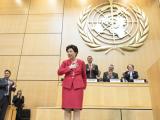Jul 16, 2010
Global cases continue at low levels
In its weekly update, the WHO reported today that global pandemic flu activity remains low, with the most active areas in parts of South Asia, West Africa, and Central America. Flu activity remains low in the temperate Southern Hemisphere during the first half of winter, except in South Africa, which has had increased detections of primarily seasonal flu (type B and A/H3N2). Pandemic flu activity in Asia remains low to sporadic, except in parts of India, Malaysia, and Singapore.
http://www.who.int/csr/don/2010_07_16/en/index.html
Jul 16 WHO update
Pathology study finds alveolar damage, bacterial co-infection
A pathology study of 100 fatal H1N1 cases from last spring found the most prominent damage to tissue was diffuse alveolar lung damage, particularly to alveolar lining cells. Also, more than 25% of patients had bacterial co-infections. Viral pneumoniaand localization of viral antigen to damaged alveoli were also prominent. The authors conclude, "Underlying medicalconditions and bacterial co-infections contributed to the fataloutcome of this infection."
http://ajp.amjpathol.org/cgi/content/abstract/amjpathol;177/1/166
July Am J Pathol abstract
One fifth of Pittsburgh patients had H1N1 antibodies
Researchers studied blood samples from Pittsburgh-area hospitals and clinics for 846 patients, roughly 100 samples for each decade of age (eg, 0 to 9) and found that seroprevalence for pandemic H1N1 flu averaged 21%. However, seroprevalence varied by age-group, with those age 10 to 19 years having the highest (45%), and patients age 70 to 79 the lowest (5%). This compares with a baseline seroprevalence of 6% among 18- to 24-year-olds for seasonal H1N1 influenza in 2008.
http://www.plosone.org/article/info%3Adoi%2F10.1371%2Fjournal.pone.0011601?rss
Jul 14 PLos ONE study


















